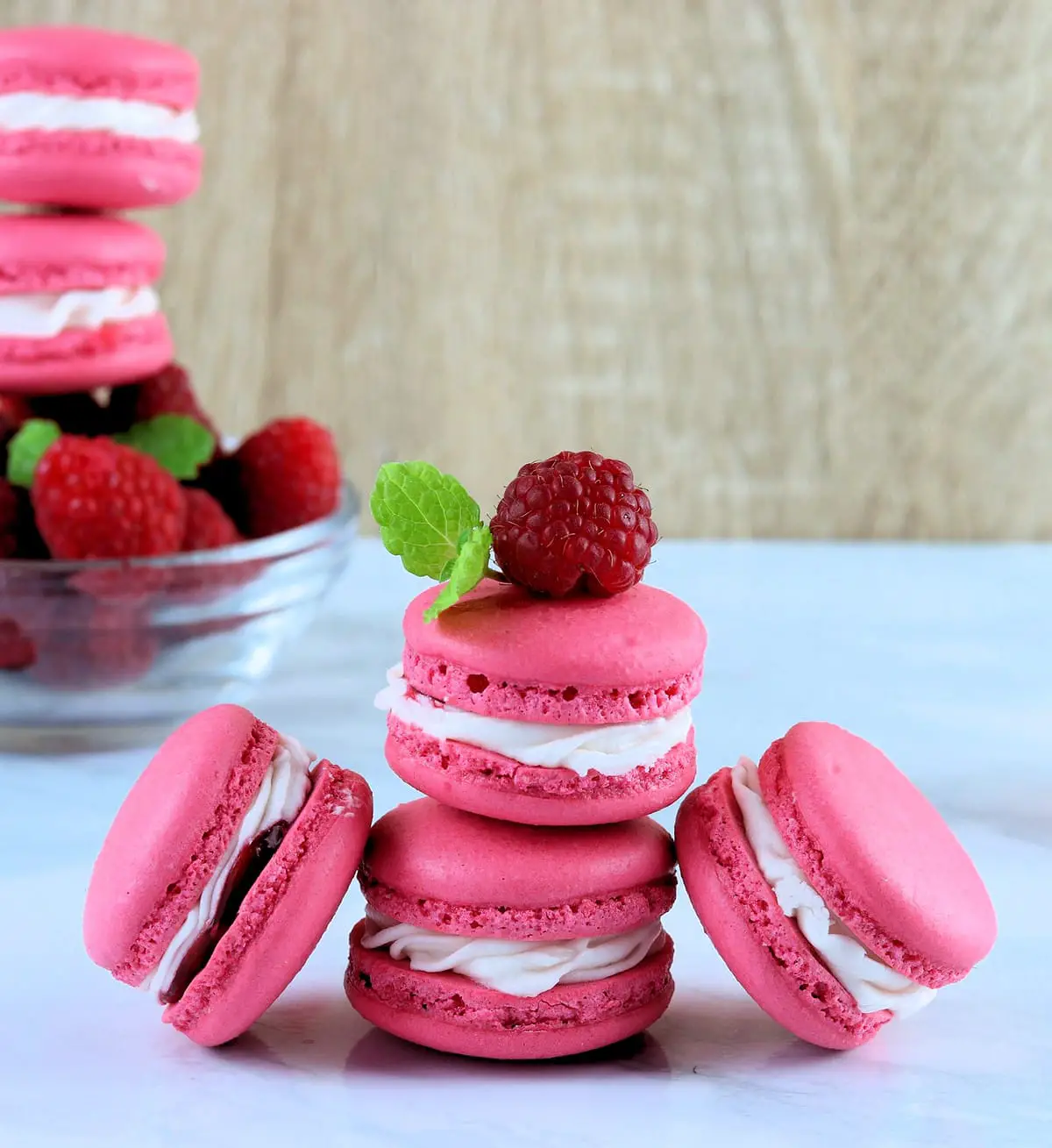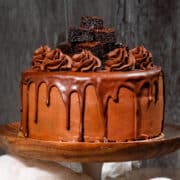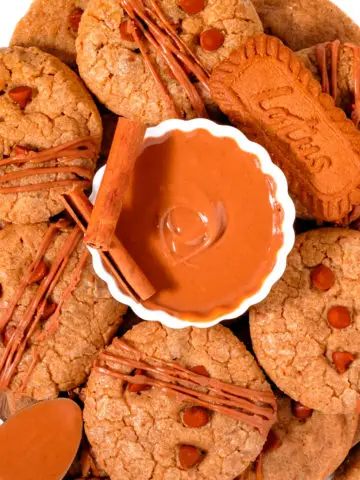Raspberry macarons are made with delicate French macaron shells that are filled with a raspberry jam and raspberry buttercream.
 To say I've become obsessed with macarons lately would be an understatement. Ever since I first learned how to make them, they have basically taken over my life. It's crazy how much science is involved in one little cookie!
To say I've become obsessed with macarons lately would be an understatement. Ever since I first learned how to make them, they have basically taken over my life. It's crazy how much science is involved in one little cookie!
Macarons are notoriously hard to make, but really, it's more that they're hard to get right. A technically perfect macaron should be round, not hollow, and have a smooth shell top with evenly developed feet underneath. I tested this recipe over and over and over again to make sure it works, and the shells came out perfect every time!
What are Macarons?
Not to be confused with macaroons, which are coconut cookies, a macaron is a delicate sandwich cookie made with almond flour and meringue. They are soft, chewy, and mildly sweet. The best way to make different flavors of macarons is through the filling. These raspberry macarons are filled with a raspberry jam and raspberry buttercream.
Meringue for Macarons
This recipe for raspberry macarons uses a French meringue, but you can also make macarons with a Swiss or an Italian meringue.
French meringue: A very simple and straightforward method for making meringue. It's also the most common and is made by whipping egg whites and sugar to stiff peaks. Of the three, the French meringue is the least stable, which means it can deflate more easily if not handled properly.
Italian meringue: The most complex method, but also the one that makes the most stable meringue. To make it, you need to whip egg whites to soft peaks while also heating a sugar syrup to a precise temperature. Once the sugar syrup reaches the exact temperature (240°F/115°C), it gets slowly drizzled into the egg whites while the mixer is still running. This is the method most pastry chefs prefer for making macarons because the results tend to be more consistent.
Swiss meringue: This method is kind of in between the two. It makes a stable meringue and is basically just as simple as the French method. The only extra step involved is whisking the sugar and egg whites over a double boiler until the sugar is dissolved.
What You Need to Make Raspberry Macarons
Almond flour: Almond flour is made from blanched almonds that have been ground into a very fine powder. To get rid of any hard clumps it's important to sift the almond flour several times through a sieve. The more you sift the better!
Sugar: Macarons are made with granulated and also powdered sugar. Powdered sugar is mixed with the almond flour to make the dry ingredients. Granulated sugar is added to the egg whites and is what gives the meringue structure.
Egg whites: The main ingredient in the meringue. Some recipes say to use aged egg whites, but I honestly don't think it's necessary. They do need to be room temperature, however, since room temperature egg whites make a more stable meringue.
Cream of tartar: Helps the egg whites whip to a greater volume and makes the meringue more stable.
Gel food coloring (optional): To dye the macarons. Gel or powder coloring is best, stay away from liquid food coloring because it can make the macaron batter too runny. Also, always add the coloring directly to the meringue. If you try to color the batter after the dry ingredients are added you're more likely to deflate the meringue.
 Equipment Needed
Equipment Needed
Kitchen scale: Weighing the ingredients is the only way to be 100% accurate, which is always important for baking, but especially for making macarons! If you don't have a scale I highly recommend getting one! They aren't very expensive and make things so much easier in the kitchen, especially if you bake often. I've gone through several different brands of kitchen scales, and this is the best one I've used by far.
Food processor: Unless you're using Baker's or caster sugar, which is already very fine, you need to process the sugar into a finer texture so it dissolves more easily in the meringue. You should also process the dry ingredients, which is the best way to get shells that are nice and smooth.
Hand-held/stand mixer: A stand mixer is easiest for making meringue, but you can make it with a hand-held mixer too.
Macaron template: Not required, but very helpful for piping even-sized shells. You can buy a reusable template or make your own by tracing 1-1.5" circles onto a sheet of parchment paper. You can reuse the homemade template several times as long as it stays clean and you don't pipe the macaron batter directly onto it.
Oven thermometer: Because your oven's temperature can be off by 50 degrees or more, an oven thermometer is a simple and inexpensive tool that can save you from many failed recipes.
How to Make Raspberry Macarons
Before you start, wash and dry any equipment (bowls, whisks, mixers, spatula, food processor, etc.) you'll be using. Even if they're already clean.
Separate the eggs while they're cold, then set the whites aside to come to room temperature. Make sure you don't get any yolk in the bowl with the whites or you won't be able to whip them to stiff peaks.
Sift the granulated sugar and then pulse it in a food processor to get a finer texture, sift again into a clean bowl and set aside.
Sift the almond flour back and forth between two bowls, at least twice but the more you sift it the better. Start with more than you think you'll need and discard any larger chunks, don't try to get them through the sifter.
Place a clean glass bowl on your food scale, set the scale to '0' (in grams), and add 100g of the sifted almond flour to the bowl. Zero out the scale (press the tare function) and sift 120g of powdered sugar into the same bowl. Add them both to your food processor and pulse for 10-15 seconds until they're a very fine texture. Sift them both again together into one bowl and set aside.
Make the Meringue
Use a hand-held mixer or the whisk attachment in your stand mixer to beat the room temperature egg whites for about 30 seconds until foamy. Add the cream of tartar and continue to whip the egg whites for about 30 seconds more or until starting to thicken.
In 3-4 additions, add the granulated sugar to the bowl and mix for about 20 seconds after each addition. Once all of the sugar is added, mix until the meringue reaches soft peaks. Add the gel food coloring and keep mixing until stiff peaks form. When you lift the mixer out of the bowl and flip it upside down the meringue should have a peak that sticks straight up.
 Macaronage
Macaronage
Macaronage is the process of combining the dry ingredients and the meringue to make the macaron batter.
Add the dry ingredients to the meringue in 3 additions and use a rubber spatula to fold in each until the batter is smooth and glossy with no pockets of flour remaining.
 After the last addition, continue to fold by wiping the sides and the bottom of the bowl until the batter is at the right consistency. When you lift the spatula up, the batter should flow continuously in thick ribbons without breaking. Lift the batter up to check often and stop folding as soon as it gets to the right consistency.
After the last addition, continue to fold by wiping the sides and the bottom of the bowl until the batter is at the right consistency. When you lift the spatula up, the batter should flow continuously in thick ribbons without breaking. Lift the batter up to check often and stop folding as soon as it gets to the right consistency.
 Pipe the Macaron Batter
Pipe the Macaron Batter
Add the macaron batter to a piping bag fitted with a ½" round piping tip or with the tip of the bag cut off.
Hold the bag straight up and down with the tip right in the center of the circle on your template. Gently squeeze until the batter almost fills the circle. Stop squeezing and finish with a quick twisting motion.
Once you've piped all of the circles, lift the pan up about 5" and drop or bang it firmly on your counter several times. You should see little air bubbles rise to the surface and pop. If you see any large bubbles on the surface that don't pop you can use a toothpick to carefully pop them yourself.
 Dry the Shells
Dry the Shells
Before baking, let the shells dry out for at least 30 minutes, or until they form a skin on the surface. You should be able to gently touch the tops without wet batter sticking to your finger.
Bake
Arrange your oven rack to the middle position.
Preheat your oven to 300°F/150°C and bake the macarons, one baking sheet at a time, for 12 minutes.
 Allow the macarons to cool completely on the baking sheet for at least 30 minutes before touching or removing them.
Allow the macarons to cool completely on the baking sheet for at least 30 minutes before touching or removing them.
Raspberry Jam & Buttercream Filling
You can use store-bought raspberry jam to fill the shells and make the buttercream, but making your own is really simple and only takes a few minutes.
- Raspberries: Fresh or frozen.
- Granulated sugar
- Fresh-squeezed lemon juice: Or water.
- Water: Or more lemon juice.
- Cornstarch
To make the raspberry jam, add the raspberries and sugar to a medium saucepan. Place over medium heat, cook and stir until the raspberries have released most of their juices. In a small bowl, whisk the water, lemon juice, and cornstarch, and add it to the pan. Cook and stir until the jam is bubbling and thick. Immediately pass the mixture through a sieve to get rid of the raspberry seeds. Cover and allow the jam to cool in the fridge.
To make the buttercream, combine softened butter, powdered sugar, heavy cream, and ½ tablespoon of the raspberry jam. Use an electric mixer or the paddle attachment in a stand mixer to beat until smooth.
To fill the raspberry macarons, take two of the macaron shells, pipe a ring of buttercream around the outside on the bottom of one, then add a dollop of raspberry jam in the center. Gently top with the second shell.
 After filling the macarons, they actually taste even better the next day, because the shells start to get infused with the flavor of the filling!
After filling the macarons, they actually taste even better the next day, because the shells start to get infused with the flavor of the filling!
How to Store Macarons
Store the raspberry macarons in an airtight container and keep in the fridge for 1 week. You can also freeze the shells for 2 months.
To freeze the macaron shells: Set them on a baking tray or plate and set them flat in the freezer until hard. Then transfer them to a container that will keep the shells from getting squished. When ready to use, thaw the shells for about 20 minutes in the fridge, fill as desired, and enjoy!

MORE MACARON RECIPES
You can also order homemade macarons in any flavor through my online shop!
📖 RECIPE

Raspberry Macarons
Equipment
- Food processor
- sieve/sifter
- Electric mixer
- piping bag
- macaron template
Ingredients
Macarons:
- 100 grams almond flour, sifted
- 120 grams powdered sugar, sifted
- 100 grams egg whites, room temperature
- ¼ teaspoon cream of tartar
- 120 grams granulated or caster sugar, sifted
- 3-4 drops red or pink gel food coloring (not liquid), optional
Raspberry Jam:
- 2 cups raspberries, fresh or frozen
- ½ cup granulated sugar
- 1 teaspoon lemon juice, or water
- 2 teaspoons water, or more lemon juice
- ½ tablespoon cornstarch
Raspberry Buttercream:
- 5 tablespoons unsalted butter, softened to room temperature
- ¾ cup powdered sugar
- 1 tablespoon heavy cream
- 2 tablespoons raspberry jam
Instructions
- Before you start, wash and dry any equipment (bowls, whisks, mixers, spatula, food processor, etc.) you’ll be using. Especially anything that's going to come into contact with the meringue.
- Prepare two large baking sheets with a macaron template (about 30 circles on each template). Cover the template with a sheet of parchment paper. The parchment paper should be the same size or slightly smaller than the baking sheet otherwise the shells can get lopsided.
- Separate the eggs while they’re cold, then set the whites aside to come to room temperature. Make sure you don’t get any of the yolk in the bowl with the whites or you won’t be able to whip them to stiff peaks.
- Sift and weigh the granulated sugar and then pulse it in a food processor to get a finer texture, sift again into a clean bowl and set aside.
- Sift the almond flour back and forth between two bowls, at least twice, but the more you sift it the better. Start with more than you need and discard any larger chunks.
- Place a clean glass bowl on your food scale, set the scale to ‘0’ (in grams), and add 100g of the sifted almond flour to the bowl. Zero out the scale and sift 120g of powdered sugar into the same bowl. Add them both to your food processor and pulse for 10-15 seconds until they’re a very fine texture. Sift them both again together into one bowl and set aside.
Make the Meringue:
- Add the room temperature egg whites to a large, clean bowl, or the bowl of your stand mixer fitted with the whisk attachment. Whip the egg whites until foamy, about 30 seconds, then add the cream of tartar and whip for another 30 seconds until starting to thicken.
- In 3-4 additions, add the granulated sugar and mix for 20 seconds after each addition. Once all of the sugar is added, whip the meringue until it reaches soft peaks (peaks that flop to the side). Add the gel food coloring (if using) and continue to whip to stiff peaks (peaks that stick straight up).
- Macaronage: In 3 additions, add the sifted dry ingredients to the meringue and use a rubber spatula to gently fold in each until the batter is smooth with no pockets of flour remaining.
- After the last addition, continue to fold by wiping the sides and the bottom of the bowl until the batter is at the right consistency. When you lift the spatula up, the batter should flow continuously in thick ribbons without breaking. Lift the batter up to check often and stop folding as soon as it gets to the right consistency.
- Pipe the shells: Add the macaron batter to a large piping bag with a ¼-½" round piping tip. Hold the piping bag straight up and down with the tip right in the center of the circle on your template. Gently squeeze the bag until the batter spreads and almost fills the circle. Stop squeezing and lift up with a quick twisting motion.
- Once you have all the shells piped, lift the pan up about 5" and drop or bang it firmly on your counter several times, you should see little air bubbles come up to the surface and pop. If you see any large bubbles that don't pop, use a toothpick to pop them yourself.
- Let the shells dry out on the pan for at least 30 minutes, or until they form a skin on the surface. You should be able to gently touch the tops without wet batter sticking to your finger.
- Arrange your oven rack to the middle position and preheat your oven to 300°F/150°C.
- Bake the macarons, one baking sheet at a time, for 12 minutes each. Take them out of the oven and let cool completely before touching them or trying to remove them from the pan.
Make the Raspberry Jam:
- Add the raspberries and sugar to a medium saucepan. Place over medium heat, cook and stir until the raspberries have released most of their juices.
- In a small bowl, whisk the water, lemon juice, and cornstarch, and add it to the pan. Continue to cook and stir until the mixture is bubbling and thick. While still warm, strain the jam through a sieve to get rid of the raspberry seeds, then cover and place in the fridge to cool.
Make the Raspberry Buttercream:
- In a medium bowl, beat the softened butter until smooth and creamy. Add about half of the powdered sugar and beat until combined. Add the cream, raspberry jam, and the rest of the powdered sugar, and beat for about 1 minute until fluffy and smooth. If the buttercream is too thick, add an additional tablespoon of cream or raspberry jam.
Fill the Shells:
- Pipe a ring of buttercream around the outside on the bottom of one shell, then add a dollop of raspberry jam in the center. Gently top with the second shell.
- Once filled, store the raspberry macarons in an airtight container and keep in the fridge for 1 week.


















Anonymous
add a little water to the buttercream